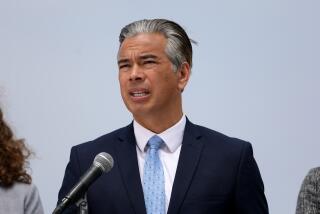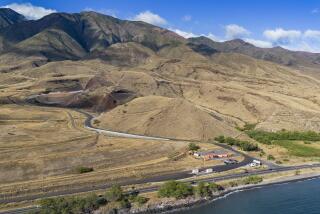U.S. Sues Oil Firms for $19 Million in McColl Dump Case : Environment: The EPA and the state of California move to establish that the seven companies are liable for cleanup costs at Fullerton’s toxic waste site--called one of the worst.
LOS ANGELES — The U.S. attorney filed a $19-million lawsuit against Shell Oil and six other companies Friday in an effort to recover the money that the federal and state governments have spent on the McColl toxic waste dump in Fullerton.
A spokesman for the oil companies, William Duchie, said Friday that he did not understand why the government had resorted to a lawsuit when the companies have proposed spending $25 million to $40 million to clean up the Superfund site.
The oil companies have steadfastly insisted that they were under orders from the U.S. military to produce high-octane aviation fuel, resulting in the waste that they dumped at McColl during World War II--and that they disposed of it legally at the time.
With the suit, the U.S. Environmental Protection Agency and the state of California seek to establish that the companies are nonetheless liable for past and future cleanup costs at one of the state’s worst toxic waste dumps.
“The Superfund trust fund is finite,” said Daniel W. McGovern, administrator of the EPA’s western regional office. “We have a responsibility to the public to recover those funds spent at the McColl site from those responsible for the contamination.”
The suit names Shell Oil, Atlantic Richfield and Texaco, whose predecessor companies allegedly dumped wastes that contaminated about 100,000 cubic yards of soil at the 22-acre site. Also named are the property’s owners, Los Coyotes Estates Ltd. and Ramparts Research and Financial Corp., both of Orange, and McAuley LCX Corp. of Buena Park.
The dump site is now located under a vacant field and part of a nine-hole golf course at Los Coyotes Country Club. It is bordered on three sides by upper-middle-class homes, whose owners have received more than $20 million in settlements with the oil companies and developers.
Friday’s lawsuit alleges that the federal government has spent at least $15 million and the state at least $3.7 million responding to the hazardous waste.
So far, however, the money has been spent stabilizing the site, studying how to perform the cleanup, testing the waste, air, water and soil, and performing sample excavations. The cleanup itself has yet to begin, and the oil companies and the EPA have long argued over how it should be accomplished.
According to Duchie, the companies want to seal and isolate the highly acidic wastes so they cannot contaminate ground water, at an estimated cost of $25 million to $40 million. The EPA wants to excavate and incinerate the waste at an estimated cost of $200 to $400 million.
In June, the EPA sued the companies seeking to force them to pay for ground-water tests, and in November, after conducting test digs, the EPA told residents that the waste could be removed with proper precautions.
EPA officials did not return telephone calls requesting comment Friday.
Duchie said the companies had expected to be dunned for the cleanup costs but did not expect a lawsuit.
“Six months ago they wrote us a letter and asked us for $19 million for past costs,” he said. “We said, ‘We’d like to consider it, but could you tell us how you expended the funds?’ Their response was they really couldn’t identify how the money was spent, but they’d seek to gather that information for us. So we’ve been waiting to hear.”
Under Superfund laws, those held liable for creating toxic waste problems cannot sue the government, on the theory that otherwise polluters could tie up cleanup efforts in court indefinitely, Duchie said.
However, once the government goes to court, the defendants can respond. While refusing comment on what the companies will do, Duchie argued that the McColl site is unlike any other Superfund site in the United States in that the waste was produced and disposed of under the direct control of the U.S. military.
“They knew the waste was being produced, they knew there was no place to put it except on the ground,” Duchie said. “They could have built a plant to treat the waste, but the materials weren’t available because they were being used in the war effort.”
Moreover, Duchie said, “Clearly it was an act of war that the waste was generated (and) that is one of the major exclusions in Superfund. . . . So we do not believe that we are responsible.”
BACKGROUND
The McColl problem began when oil companies producing aviation fuel for the military during World War II disposed of waste materials in 12 sumps operated by Eli McColl in then-rural Fullerton. Federal and state officials ultimately determined that an estimated 150,000 tons of toxic waste in the soil contains sulfuric acid, benzene and arsenic, and that fumes caused nearby residents to suffer headaches, nausea and respiratory problems. In 1982, McColl was declared a Superfund site. Though the government says that it has spent $19 million studying the problem, the waste has yet to be cleaned up. The federal Environmental Protection Agency wants to dig up and burn the waste, while the oil companies want to cover and seal it.
More to Read
Sign up for Essential California
The most important California stories and recommendations in your inbox every morning.
You may occasionally receive promotional content from the Los Angeles Times.










